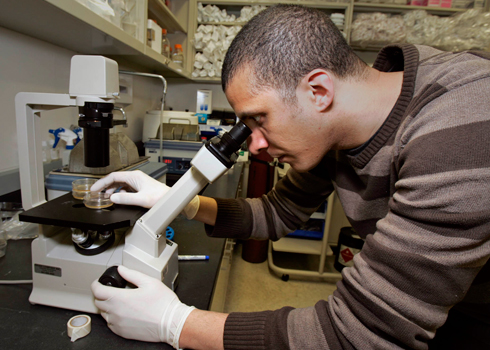A U.S. District Court judge’s ruling yesterday halting the federal funding of embryonic stem cell research with a preliminary injunction pending a trial has left the scientific community stunned, and Congress wondering if any next steps are possible in an election year. The administration’s silence isn’t unexpected, but it’s more surprising that senators or members of Congress known to be supportive of stem cell research haven’t commented.
While U.S. District Court Judge Royce Lamberth explicitly stated the government is barred from taking “any action whatsoever” in his ruling, several experts TPM contacted said it’s not clear if scientists will need to stop work already in progress or if they will just be restricted from obtaining any new funding. Even the lawyers for the plaintiffs told the Washington Post they need Lamberth to clarify the existing versus new funding question. But people in both the legal and scientific fields believe the temporary injunction makes research funding even more restrictive than it was under former President George W. Bush’s administration. Though not spelled out explicitly in the ruling, the most common interpretation is that research conducted under the Bush-era policy of allowing research into existing stem cells lines would be halted under the ruling.
Lamberth found that the new guidelines President Obama issued when he took office, which allowed taxpayer dollars to fund embroynic stem cell research on cells derived from embryos, violates the Dickey-Wicker amendment. The amendment is an obscure budgetary action taken by Congress in 1996 to ban federal funding for research that destroys human embryos. But when Obama issued his executive order allowing for the National Institutes of Health to create the guidelines, they were written with the long-held Dickey-Wicker amendment in mind. Pro-stem cell research groups said yesterday they worked in conjunction with NIH in an “extensive, deliberative process” to make sure Dickey-Wicker wasn’t violated.
When Lamberth’s surprise ruling came down yesterday, several research groups and organizations studying diseases helped by stem cell research said it was a devastating setback highly disruptive to their research, while religious and pro-life groups hailed it as a victory. Lamberth found that Dickey-Wicker is “unambiguous” and concluded that embryonic stem cell research “is research in which a human embryo is destroyed.”
In the ruling, Lamberth actually cites a 2009 Random House dictionary to define “research” as more than just “a piece of research” to puncture the government’s claim that the research it funds doesn’t result in the destruction of embryos. He wrote:
ESC research is clearly research in which an embryo is destroyed. To conduct ESC research, ESCs must be derived from an embryo. The process of deriving ESCs from an embryo results in the destruction of the embryo. Thus, ESC research necessarily depends upon the destruction of a human embryo.
The Justice Department told TPM they are reviewing the case, but the administration has limited options — appeal the injunction, or write new guidelines that get around Lamberth’s ruling. Neither will be easy in an election year. Top Congressional aides and administration officials were caught unprepared given that it’s summer recess. But House Democrats will talk through the ruling this morning on an already planned leadership call and clearer game plan might emerge, aides told TPM.
But the question about Lamberth’s ruling and its implications remain. One molecular cell biologist we spoke with highlighted this portion of the ruling:
This prohibition encompasses all “research in which” an embryo is destroyed, not just the “piece of research” in which the embryo is destroyed. Had Congress intended to limit the Dickey-Wicker to only those discrete acts that result in the destruction of an embryo, like the derivation of ESCs, or to research on the embryo itself, Congress could have written the statute that way.
Congress, however, has not written the statute that way, and this Court is bound to apply the law as it is written. Accordingly, this Court must “give effect to the unambiguously expressed intent of Congress” to prohibit federal funding of research in which a human embryo is destroyed. Chevron, 467 U.S. at 843.
Dickey-Wicker has been renewed by Congress every year, and Bush’s 2001 decision allowed for limited research on a handful of already extracted embryonic stem cells.
In its statement opposing the ruling, the American Society for Reproductive Medicine argued, “[B]y finding that there could be harm to adult stem cell researchers if embryonic stem cell work gets funding, this Judge opens the door for every scientist who ever has a grant request rejected on the merits to sue the federal government.”
Think Progress believes the ruling moves the law “to a worse position than it was during the Bush administration. President George W. Bush allowed federal funding for research on existing embryonic stem cell lines, but would not allow new lines to be created. Today’s opinion even forbids such entirely uncontroversial research.”
This blogger, a molecular biology Ph.D. student, argues that “two very conservative Christian organizations that happen to engage in scientific research … have succeeded in loophole-ing an entire Executive Department into bowing to their will.”









